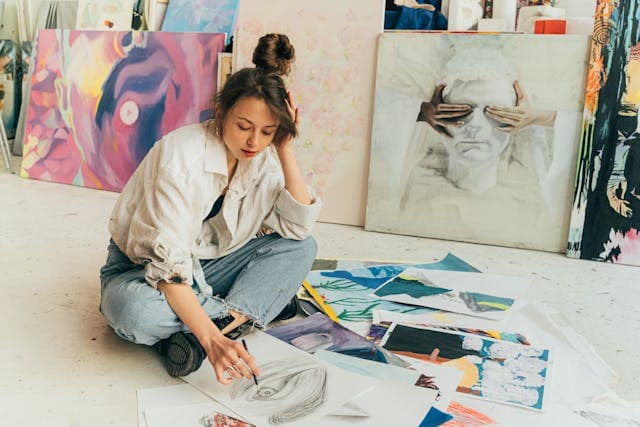The world of fine arts is a realm of boundless creativity, where imagination takes flight and expression knows no bounds. For aspiring artists, pursuing a diploma in fine arts is more than just honing their skills—it’s a transformative journey that allows them to explore their creativity, refine their techniques, and unleash their artistic potential. In this blog, we’ll delve into the journey from canvas to concept, exploring the significance of a diploma in fine arts and the possibilities it opens up for those who aspire to master their craft.
The Essence of Fine Arts
Understanding Fine Arts
Fine arts encompass a diverse range of artistic disciplines, including painting, drawing, sculpture, printmaking, photography, and more. At its core, fine art is about self-expression, communication, and interpretation, transcending cultural boundaries and challenging conventional norms. Artists use various mediums, techniques, and styles to convey their ideas, emotions, and perspectives, inviting viewers to engage with their work on a deeper level.
The Role of a Diploma in Fine Arts
A diploma in fine arts provides aspiring artists with a structured pathway to develop their skills, expand their artistic horizons, and prepare for a career in the arts. Whether through studio practice, art history courses, or mentorship from experienced faculty, students gain invaluable insights and guidance that help them grow as artists. A diploma in fine arts lays the foundation for further academic pursuits, such as a master’s degree in fine arts, or entry into the professional art world.

Embarking on the Journey
The Curriculum Journey
The curriculum of a diploma in fine arts program is designed to provide students with a comprehensive understanding of artistic techniques, concepts, and theories. From foundational drawing and painting courses to specialized studies in areas such as figure drawing, still life, landscape painting, and abstract expressionism, students are exposed to a wide range of artistic approaches and traditions. Through hands-on studio sessions, critiques, and discussions, students learn to experiment, take risks, and push the boundaries of their creativity.
Mastering the Craft
For those who aspire to take their artistic journey to the next level, pursuing a master’s degree in fine arts (MFA) offers an opportunity for deeper exploration and specialization. A master’s program provides students with the opportunity to refine their artistic voice, conduct independent research, and engage in critical dialogue with peers and faculty. Whether through thesis projects, exhibitions, or artist residencies, students emerge from a master’s program with a heightened sense of artistic identity and a body of work that reflects their personal vision and growth.
The Transformative Power of Art
Personal Growth and Self-Expression
For many artists, the journey of pursuing a diploma in fine arts is as much about personal growth and self-discovery as it is about technical skill development. Through their artwork, artists explore themes of identity, memory, social justice, and spirituality, using their creative practice as a means of self-expression and reflection. The process of creating art allows artists to connect with their innermost thoughts and emotions, leading to moments of insight, catharsis, and transformation.
Connecting with the World
Art has the power to transcend language barriers and cultural differences, serving as a universal language that speaks to the shared human experience. Through their artwork, artists have the ability to engage with viewers on a profound level, sparking dialogue, provoking thought, and inspiring change. Whether through exhibitions, public installations, or online platforms, artists have the opportunity to connect with audiences around the world, fostering empathy, understanding, and connection.
Charting a Path Forward
Career Opportunities in Fine Arts
Graduates of a diploma in fine arts program can pursue a variety of career paths in the arts and creative industries. Some may choose to work as practicing artists, exhibiting their work in galleries, museums, and alternative art spaces. Others may explore opportunities in art education, arts administration, curation, or art therapy. Additionally, some artists may choose to pursue freelance work, commissions, or public art projects, allowing them to share their creativity with a broader audience.
Pursuing a Master’s Degree in Fine Arts
For those seeking to further their artistic practice and academic credentials, pursuing a master’s degree in fine arts offers a pathway to advanced study and specialization. A master’s program provides students with the opportunity to develop a body of work that reflects their artistic vision and conceptual interests. Additionally, it opens up opportunities for teaching, research, and exhibition opportunities, as well as networking within the art world.
Conclusion: Embracing the Journey
In conclusion, the journey from canvas to concept is a transformative experience that shapes aspiring artists into masters of their craft. Whether pursuing a diploma in fine arts or advancing to a master’s degree, the pursuit of artistic excellence requires dedication, passion, and a willingness to embrace the unknown. Through their creative practice, artists have the power to inspire, provoke, and challenge the world around them, leaving an indelible mark on society and culture. As they navigate the complexities of the artistic landscape, aspiring artists must remain true to their vision, trusting in the transformative power of art to illuminate the path forward.

